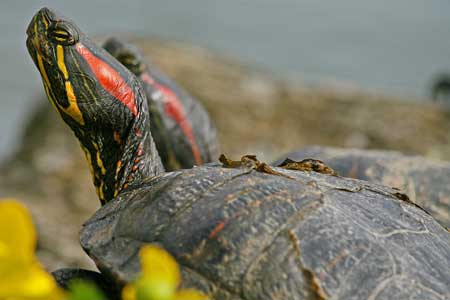Red Eared Turtles Care Guide
How to properly look after these long-living pets
Red Eared Turtles are entertaining and long living pets that can make an excellent addition to your family. To help them be around for as long as possible lets first read up on them to understand more about the care required.
Why Red Eared Turtles make great pets:
Red eared turtles are recognised by the vibrant red stripes on the sides of the head. They are hardy and can adapt to most situations. Females grow up to 30cm while males reach up to 18cm. As you get to know them, you will notice individual characteristics and habits. Every turtle is entertaining in their own way and will get to know your daily schedule, ensuring you do not forget to feed them.
Turtle tank requirements:
We recommend that you get the largest aquarium you can either afford or accommodate as turtles can grow quite large and at a fast pace. The minimum size that we would recommend is a 60cm x 30cm x 30cm tank. This should be large enough for the first 18 months following which you would then nee to move up to a 90cm tank once your turtles shell is 8cm round.

Ramp
- It is important to have a ramp or dry area out of the water that the turtle can access for sunbathing, basking and drying off.
Heater
- The water in your turtle’s tank will need to be heated using an aquarium heater with an inbuilt temperature gauge. This should be set at 26°C and attached to the glass on an angle to aid with heat distribution.
- Please note: A heater should never be removed from the water unless it has been turned off for ten minutes to allow it to cool.
Maitenance
- Depending on the type of filtration unit you decide to get most filters need to be cleaned at least once a week.
- We also recommend that you change 50% – 80% the water once a week.
- Turtles are very messy creatures and a filter is essential if you want to keep the water clean and reasonably odour free.
Diet
- It is best to feed a variety of foods to your turtle.
- One of the types of food we recommend you feed is a specific frozen food for turtles as this contains essential vitamins and minerals including calcium which is needed for the development of a turtle’s shell.
- You should also include some form of vegetation in their diet like oxygen weed or aquarium plants as well as feeding a dried pellet or shrimp. These foods should be fed on a daily basis at approximately the same time.
- We recommend removing left over food ten minutes after feeding to avoid waste build up.
- As an item of general care it is recommended to add calcium blocks to the water to aid in healthy shell growth.
Lighting
Turtles must have a fluorescent light above the aquarium. It is advised to be a specific reptile tube as these are specially formulated to provide the correct levels of light turtles require to produce vitamin D³, these need to be replaced every 12 months.

The light needs to be on for 12 hours a day, no more, no less. We also recommend that there is no glass lid or plastic light cover stopping the light from directly hitting the turtles shell.
Fun Facts:
- Turtles live in captivity for approximately 17 to 25 years
- An adult turtle can produce up to 1 litre of urine a day
- Females can grow up to 20-30cm
- Males can grow up to 13-18cm
- The easiest way of determing the sex of the turtle is with the claws – the male has much longer claws than the females.
15319